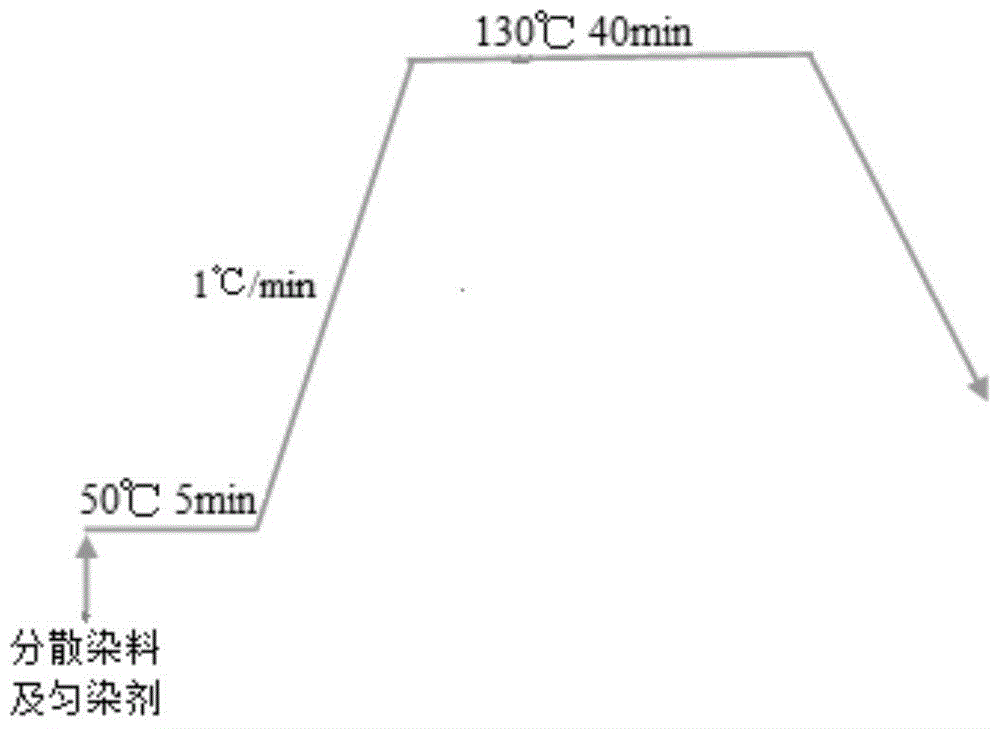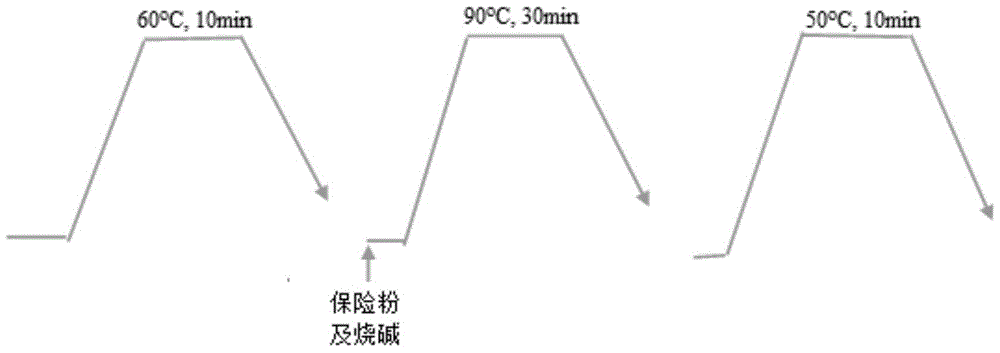In-situ mineralization of disperse dyes, deep water saving and emission reduction dyeing post-treatment method and auxiliaries
A technology of disperse dyes and in-situ mineralization, applied in the field of textile dyeing and finishing, can solve problems such as poor practicability, no new dyeing technology found, and problems in production technology that cannot be satisfactorily solved, and achieves dyeing color fastness guarantee, The effect of saving dyeing water and shortening the dyeing processing time
- Summary
- Abstract
- Description
- Claims
- Application Information
AI Technical Summary
Problems solved by technology
Method used
Image
Examples
preparation example Construction
[0081] The preparation method of disperse dyeing post-processing auxiliary agent XBD is specifically implemented according to the following steps:
[0082] Step 1, take raw materials respectively by mass percentage:
[0083] Polyacrylamide 0.001%~5%, polyaluminum sulfate or polyaluminum chloride 0.001%~2.5%, sulfuric acid 0.001%~3%, ferrous salt 0.001%~10%, fatty alcohol polyoxyethylene ether 0.001%~15% , sodium alkylsulfonate 1.0%-10%, sodium alkylsulfate 1.0%-10%, chelating agent 0.001%-25%, purified water 19.5%-97.994%, the total content of the above components is 100%;
[0084] Step 2, heating the purified water weighed in step 1 to 40°C to 50°C;
[0085] Step 3, polyacrylamide, polyaluminum sulfate or polyaluminum chloride, sulfuric acid, ferrous salt, fatty alcohol polyoxyethylene ether, alkyl sodium sulfonate, alkyl sodium sulfate and chelating agent weighed in step 1 Add together the purified water obtained in step 2 at a temperature of 40°C to 50°C, and stir evenly ...
Embodiment 1
[0122] Preparation of disperse dyeing post-treatment auxiliary XBD;
[0123] Disperse dyeing post-processing auxiliary XBD, weigh the following raw materials according to mass percentage: polyacrylamide 2.5%, polyaluminum sulfate 1%, sulfuric acid 0.5%, ferrous chloride 3%, Pingpingjiao 10%, dodecane 5% sodium dodecyl sulfate, 5% sodium dodecyl sulfate, 1.5% lactic acid, the mass ratio of pure water is 71.5%, the total content of the above components is 100%; the polyacrylamide, polyaluminum sulfate , sulfuric acid, ferrous chloride, flat plus O, sodium lauryl sulfate, sodium lauryl sulfate and lactic acid are dissolved in pure water at a temperature of 40 °C, and after being stirred evenly, a disperse dye dyeing post-processing aid is formed. Agent XBD;
[0124] Preparation of disperse dyeing post-processing auxiliary XYD:
[0125] XYD, the post-processing auxiliary agent for disperse dyeing, weighs the following raw materials according to mass percentage: 80% hydrogen pero...
Embodiment 2
[0132] Preparation of disperse dyeing post-treatment auxiliary XBD;
[0133] Disperse dyeing post-processing auxiliary XBD, weigh the following raw materials according to mass percentage: polyacrylamide 2%, polyaluminum sulfate 1.5%, sulfuric acid 0.6%, ferrous sulfate 2%, Pingpingjiao 12%, dodecyl Sodium sulfate 3%, sodium dodecylsulfonate 4%, ethylenediaminetetraacetic acid 1%, the mass ratio of pure water is 83.9%, the content sum of above components is 100%; The polyacrylamide that weighs, Polymerized aluminum sulfate, sulfuric acid, ferrous sulfate, Pinga O, sodium lauryl sulfate, sodium dodecyl sulfate and ethylenediaminetetraacetic acid are dissolved in pure water at 43 ° C, and after being stirred evenly, disperse dyes are formed. Post-treatment additive XBD;
[0134] Preparation of disperse dyeing post-processing auxiliary XYD:
[0135] XYD, the post-processing auxiliary agent for disperse dyeing, weighs the following raw materials according to mass percentage: 70% ...
PUM
 Login to View More
Login to View More Abstract
Description
Claims
Application Information
 Login to View More
Login to View More - R&D
- Intellectual Property
- Life Sciences
- Materials
- Tech Scout
- Unparalleled Data Quality
- Higher Quality Content
- 60% Fewer Hallucinations
Browse by: Latest US Patents, China's latest patents, Technical Efficacy Thesaurus, Application Domain, Technology Topic, Popular Technical Reports.
© 2025 PatSnap. All rights reserved.Legal|Privacy policy|Modern Slavery Act Transparency Statement|Sitemap|About US| Contact US: help@patsnap.com



